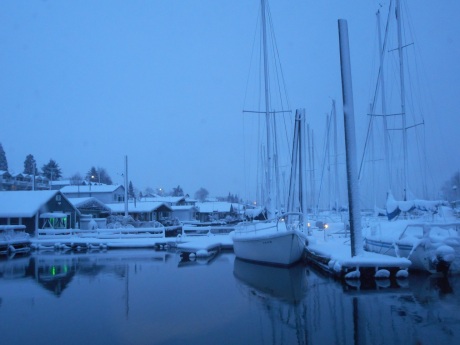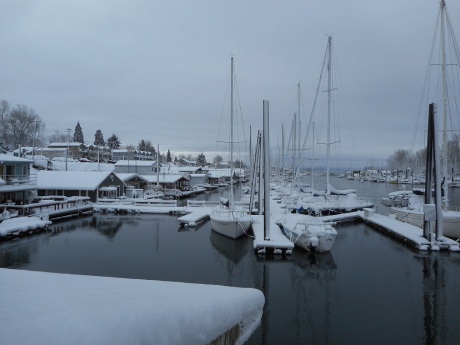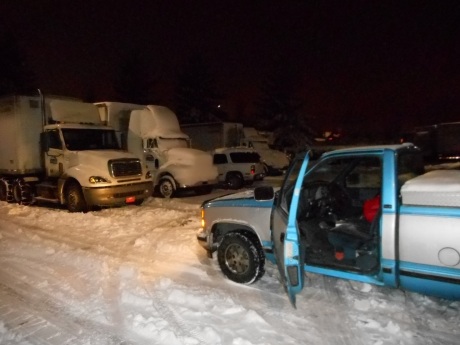Snowstorm Reflections on Collapse and Recovery
15 January 2017
Sunday

Early in the history of this blog I wrote about a snowstorm in Portland during December 2008, Snow in Portland, More Snow, and Lessons from a Snowstorm, and now Portland has had another uncharacteristically heavy snowfall eight years on. I am always fascinated to watch the rapidly changing behaviors of the population of a city as it responds to rapidly changing conditions, and I can’t help but extrapolate from these observations to other disruptions to the ordinary business of life.

The initial impact of a big snowstorm (in a temperate climate where snowstorms are infrequent) is chaos and frantic activity. After the initial chaos, the city goes quiet, and driving around a city after it has gone quiet gives an apocalyptic feeling, as though the end of the world has come. A snowstorm is, in miniature, the collapse of a complex society, such as Joseph Tainter wrote about:
“Collapse, as viewed in the present work, is a political process. It may, and often does, have consequences in such areas as economics, art, and literature, but it is fundamentally a matter of the sociopolitical sphere. A society has collapsed when it displays a rapid, significant loss of an established level of sociopolitical complexity. The term ‘established level’ is important. To qualify as an instance of collapse a society must have been at, or developing toward, a level of complexity for more than one or two generations. The demise of the Carolingian Empire, thus, is not a case of collapse — merely an unsuccessful attempt at empire building. The collapse, in turn, must be rapid — taking no more than a few decades — and must entail a substantial loss of sociopolitical structure. Losses that are less severe, or take longer to occur, are to be considered cases of weakness and decline.”
Joseph A. Tainter, The Collapse of Complex Societies, Cambridge: Cambridge University Press, 1988, p. 4
Of course, the collapse precipitated by a snowstorm is not a political collapse, but it is a rapid and significant loss of an established level of complexity, and a temporary return to a simpler way of life.

When someone abandons their car and walks away, eventually walking around their neighborhood rather than driving, this is a significant simplification of life, and the simplest level to which life can be reduced is that of mere survival, or perhaps I should say subsistence. Because the conditions of a snowstorm or a flood or some similar disruption (say, a power outage) are temporary it does not force a return to subsistence agriculture, but there are occasions when one finds oneself no longer concerned by the technical details of one’s work, and one is only fighting to stay alive, as all other considerations are thrust aside in order to deal with the immediacy of the circumstances. However, it is easy to imagine (especially with the looming specter of climate change) that a storm could be the first disruption in a series of escalating disruptions that could force society to abandon its complex institutions and way of life, returning to subsistence agriculture, or even nomadic hunting and gathering. If a large flood failed to recede after a few days because water levels had crept higher, the disruption of the the storm that caused the flood would be a mere foretaste of things to come.

There is a great deal of social momentum behind the ordinary business of life, and one can observe that people continue to go about their routines in the routine way for as along as possible — right up the moment when it becomes actually physically impossible to continue to going about things as usual. Thus one sees people setting out for work as usual even as the snow is beginning to fall, and as the snow piles up they try to continue to go about their business. It is only when, on the drive home, their car will not move forward another inch, when they abandon it and walk away. As long as a choice remains, most will choose to continue with the ordinary business of life; the routine is only abandoned when no choice remains and one is forced by circumstances to alter one’s behavior.

There is also a strong desire to return to normalcy after the disruption of a storm, so that at the first sign of conditions improving, people head out again in large numbers. In the case of the snowstorms I have seen in my years, this creates a problem because the main roads will be cleared of snow, but the secondary roads and parking lots are still icy, and many people over-confidently driving at full speed on the highways cause problems for themselves and others. The desire for the return to normalcy is a desire for the familiar normalcy, the old normal, while the conditions of the storm, strange and unfamiliar at first, dictate a new normal, and there is a tension between the old normal and the new normal as society attempt to adjust and compensate for changed conditions. As long as the conditions of the new normal are temporary, the old normal will return, but the longer the conditions persist, the longer the new normal persists, and, as the phrase implies, the new normal eventually becomes familiar if it endures for a sufficient period of time.

I imagine that in the case of the true collapse of societies, and not merely an ephemeral collapse precipitated by a weather event, that this desire to return to normalcy results in a lot of false starts, like commuters returning to the roads too soon after a snowstorm. There are probably many hopeful moments in the collapse of a society when people come out of their hiding places and venture out into the world again, hoping that they can return to their routines. When Sarajevo was under siege during the Balkan wars of the 90s, it was several years before life could return to normal. Similarly, when the First and Second World Wars began, it would be several years before normalcy would return.

When a society well and truly collapses, never to rise again, one can imagine for years or for decades people looked for a return to normalcy that would never come. Or if life seemed to return to normal for a time — for weeks or months or years — it was only a deceptive return to old ways that would soon disappear forever. When Roman cities in the west began to fail, there was probably a movement like the ebb and flow of the tide, when people would abandon their city, then go back, then abandon it again. Each time those who returned would be fewer in number, there would be fewer shops open, and fewer goods for sale, and there might be increasing lengths of time between abandonment and return, until eventually the period of abandonment stretched into years, and the city fell into disrepair, fit only for looting from the ruins.
. . . . .
. . . . .
. . . . .
. . . . .




